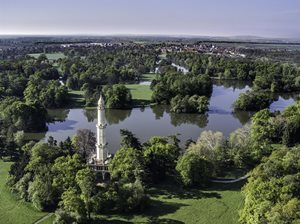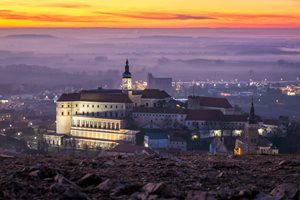The House of Liechtenstein is one of the oldest noble families in Central Europe. For over 700 years, they lived and reigned on estates that are located across all of Moravia. But their main seat was always in South Moravia. They used to own the chateaus in Valtice, Lednice, Bučovice, Úsov, Plumlov, and Velké Losiny, as well as the towns of Břeclav, Opava, and Krnov. They significantly contributed to forming the cultures there, and they were instrumental in developing viniculture and horse-breeding. A trip in the footsteps of the House of Liechtenstein will be full of surprises!
A Huge Park, Stretching As Far as the Eye Can See.
 In South Moravia, by the border with Austria, there are the towns of Valtice, with majestic Baroque chateau, and Lednice, which boasts a romantic neo-Gothic summer house. Both chateaus used to belong to the House of Liechtenstein, and they created a composed landscape area between the two. Today, this is called the Lednice–Valtice Cultural Landscape and it is registered on the UNESCO World Heritage List. The area was built during the 18th and 19th centuries and it was originally intended to be the centrepiece of their estate. Today you can find more than just chateaus and parks: there are structures both large and small dotting the area, such as the historic palm tree greenhouse, the Apollo Temple, the artificial ruins known as Jan’s Castle, the Reistna Colonnade, the Pohansko House, the Temple of the Three Graces, the Diana Temple known as ‘Rendezvous’, a hunter’s lodge with an unusual form of a classic triumphal arch, and a 62-metre-high minaret built in 1802, which is the oldest accessible lookout structure in the Czech Republic. The whole area is best enjoyed on a bike.
In South Moravia, by the border with Austria, there are the towns of Valtice, with majestic Baroque chateau, and Lednice, which boasts a romantic neo-Gothic summer house. Both chateaus used to belong to the House of Liechtenstein, and they created a composed landscape area between the two. Today, this is called the Lednice–Valtice Cultural Landscape and it is registered on the UNESCO World Heritage List. The area was built during the 18th and 19th centuries and it was originally intended to be the centrepiece of their estate. Today you can find more than just chateaus and parks: there are structures both large and small dotting the area, such as the historic palm tree greenhouse, the Apollo Temple, the artificial ruins known as Jan’s Castle, the Reistna Colonnade, the Pohansko House, the Temple of the Three Graces, the Diana Temple known as ‘Rendezvous’, a hunter’s lodge with an unusual form of a classic triumphal arch, and a 62-metre-high minaret built in 1802, which is the oldest accessible lookout structure in the Czech Republic. The whole area is best enjoyed on a bike. Liechtenstein Chateaus
 The noble family owned other chateaus outside Lednice and Valtice; in fact, they are dotted throughout Moravia and Silesia. Other monuments that left behind include chateaus in Mikulov and Bučovice, and the Šternberk Castle. The Baroque structure that dominates Mikulov in South Moravia is now a home to a museum, which has installed the largest vinicultural exposition in the Czech Republic in the chateau’s rooms and basement. When on tour, do not miss the huge wine barrel from 1643!
The noble family owned other chateaus outside Lednice and Valtice; in fact, they are dotted throughout Moravia and Silesia. Other monuments that left behind include chateaus in Mikulov and Bučovice, and the Šternberk Castle. The Baroque structure that dominates Mikulov in South Moravia is now a home to a museum, which has installed the largest vinicultural exposition in the Czech Republic in the chateau’s rooms and basement. When on tour, do not miss the huge wine barrel from 1643!The Renaissance chateau in Bučovice near Brno is also worth a visit. You can explore its characteristically Renaissance arcade and courtyard complete with Mannerist fountain, or you can admire the beautiful halls with exceptionally interesting murals – for example, the Hall of the Senses with its allegories of human senses in the form of female figures and animals. An interesting fact is that the unique stucco decoration of the Imperial Hall was originally designed for the Habsburg residence in Vienna. The chateau is complimented with a perfectly symmetrical Baroque garden.
Šternberk Castle can be found slightly farther north, past the city of Olomouc in Central Moravia. The castle today looks much like it did at the end of the 19th century when Johann II, Prince of Liechtenstein, furnished it with historical furniture, paintings, sculptures, and historical tapestries. The interiors look like exhibition cases and closely document the collecting passion of the owner. He focused on collecting artefacts of the Italian Renaissance and amassed quite a large collection even by today’s standards. Do not miss a stroll through the castle forest park, which was founded at the beginning of the 20th century.
The House of Liechtenstein has left traces in many other places besides, such as the church in Křtiny, Slavkov, and Moravský Krumlov. Their family tomb, a mausoleum, in Vranov u Brna is also very interesting. It is the only European burial ground of the rulers of an independent country – Liechtenstein – to be located in the territory of a foreign country.










-(1).jpg?width=1920&height=1204&ext=.jpg)
